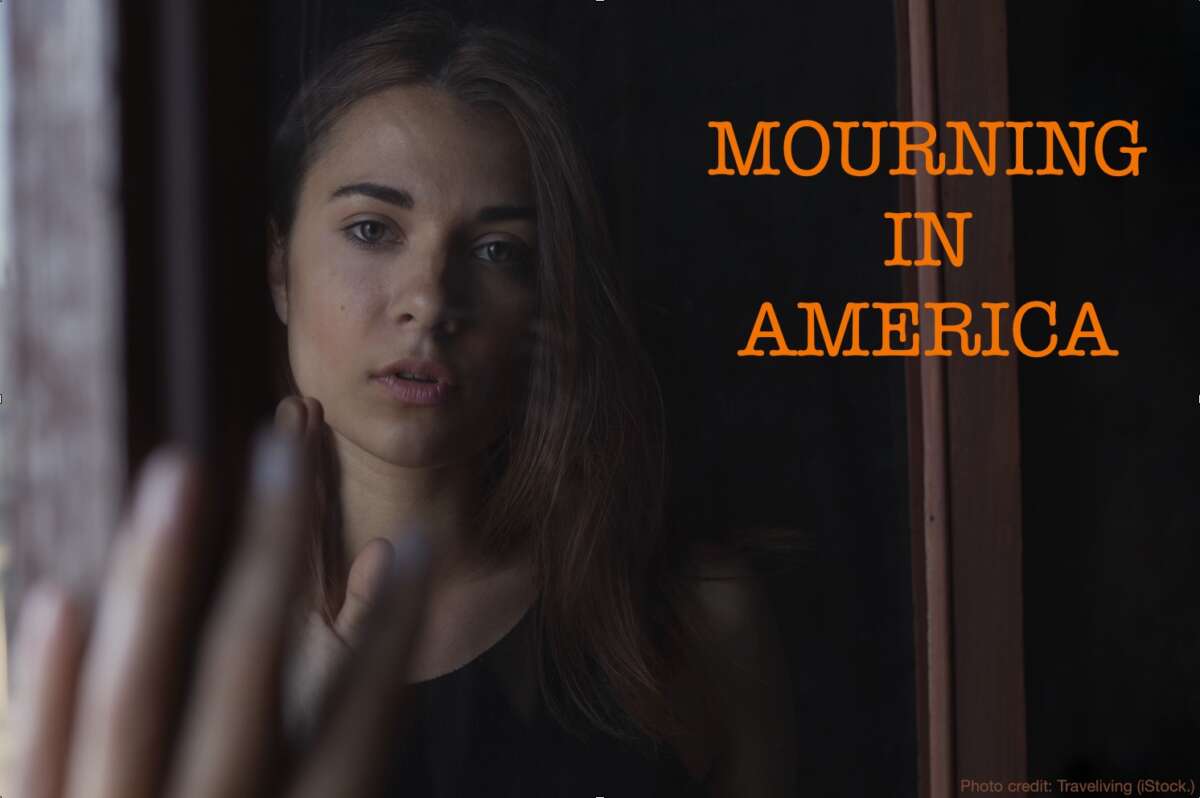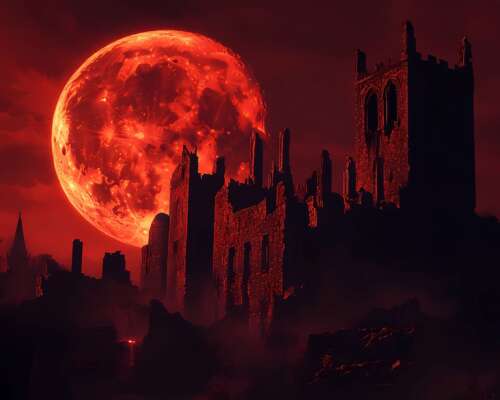NOTE: This post (Mourning in America) will be a just a small tile in the mosaic portraying the decline of this once great nation. It may be of use to some future generation trying to grasp what people in the U.S. were feeling and thinking in the year 2025 much as Germans pondered the loss of their individual freedoms and the rise of National Socialism almost a century ago.
MARCH 29, 2025 (SATURDAY)
I left the house at 9:00 a.m. to get our car serviced. It was a wet, early spring day and cold (38o.) As I approached the center of our town, I noted the lack of traffic and the appearance of a thirty-or forty-year old, well-dressed woman in a Lands’ End down jacket on the sidewalk carrying a bright orange sign. There were five or six lines of lettering on the sign, but all I could read as I drove by were the words “Stock up.”
Stock up on what? Cash? Food? Ammunition? Two hours later when my errand was done, I returned to the same intersection but she was gone, as was her portentous warning. It was troubling enough to lead me to begin this post.
MY TOWN

My town is an ideal place to live, with the choice of either city life or wilderness twenty minutes-drive from here in opposite directions. It has a rich history as one of the birthplaces of democracy in America. People in New England care about things like this. Though my town is technically not one of the six New England states, we are only 44 miles to North Adams, MA and less than that to Bennington, VT. On the town square where I saw the woman this morning, you’ll find members of a local church demonstrating for Jesus one week night and peace protestors in support of Gazans on another week night. Everyone gets along. Free speech is not only cherished here, but it is practiced as well.
I guess I wondered whether that lonely person with a sign this morning was some sort of sentinel of a coming event. Did she know something that I did not? Or was she driven by inarticulate impulse to warn us of what lay ahead? Like a mysterious and rarely seen oarfish washed up on a beach weeks before an earthquake or the sudden, large-scale migration of birds days before a hurricane hits. Yet, where I live, we have neither beaches for oarfish nor hurricanes to alarm with any frequency.
I hope to make daily contributions to this post in the weeks and months ahead. My goal is to transform the reality of mourning in America to the hope of morning in America.
MARCH 30, 2025 (SUNDAY)
For anyone who really cares, President Trump says he is “pissed off” today. Get over it Mr. President. Or, better yet, go join Joe Biden in retirement.
I remember when Donald Trump was sworn in as President in January 2017. Though I hoped for the best, I expected the worst and President Trump did not disappoint. Oddly at the time, I thought of The Decameron. The Decameron was a 14th century book written by Giovanni Boccaccio. The setting for the book was a villa near Florence, Italy in the time of the plague, the Black Death. The plague is called the bubonic plague because of the softball-sized swellings (called buboes) in the armpits and groins (boubons) of the victims. Eventually, a madness follows just before death. Plague is almost always spread by fleas on the Norwegian brown rat.
According to contemporary observer Jean de Venette’s “Chronique“:
“At Paris and in the kingdom of France, as in the other parts of the world, so it is said, there was in this same year (1348) and the year following so great a mortality of people of both sexes, of the young rather than of the old, that it was scarcely possible to bury them. They were only ill for two or three days and died suddenly, their bodies almost sound; and he, who one day was in good health, was dead and buried on the morrow. They had swellings under the arm-pits and in the groin, and the appearance of these swellings was an infallible sign of death. This malady or pest was called an epidemic by the doctors. During these two years there was such a number of victims as had never been heard of, or seen, or read of in past times. And in many towns, great and small, the priests were terrified and fled; but some others, considerably braver, administered the sacraments. Soon in many places out of every twenty inhabitants there were only two alive. The mortality was so great at the Hôtel-Dieu in Paris that for a long time more than five hundred dead were carried daily on wagons to be buried at the cemetery of St. Innocent of Paris. And the holy sisters of the Hôtel-Dieu, having no fear of death, discharged their task to the end with the most perfect gentleness and humility. These sisters were wiped out by death and were replaced more than once; and they now, as is piously believed, repose in peace with Christ.
This plague, it is said, began amongst the infidels, and then came to Italy, Crossing the mountains, it reached Avignon, where it struck down several cardinals and decimated their suites. Then by degrees it passed across Spain and Gascony, from town to town, from village to village, finally from house to house and from person to person till it arrived in France, and spread on to Germany, though it was less terrible there than it was amongst us.”
Few people indeed were spared.
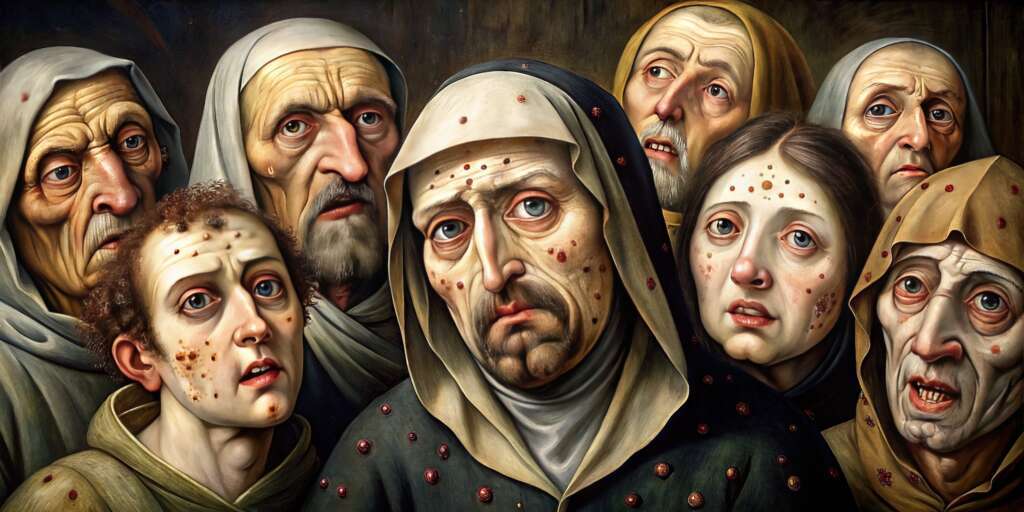
In Boccaccio’s book, seven young women and three young men camped out for ten days in seclusion in the countryside, to avoid getting sick and dying from the pestilence, hence the book’s name δέκα, for “ten”and ἡμέρα, meaning “day.” The group calculated that in ten days-time, the plague would have burned itself out and Florence would once again be safe to return to. During their exile, the ten young adults crafted a hundred stories, poems and plays to act out as they whiled the time away. It’s been a while since I read the book. Possibly, some musical compositions were included. Boccaccio says nothing of the fate of the Florentines upon their return to their homes. In my musing back then, I wondered if this theme could be adapted to the madness of the first Trump Administration? But then, who would volunteer to go into seclusion and where? Certainly not a quarantine for a four-year period, but perhaps for a symbolic ten days to draw the analysis. Or for a contemporary revision of Boccaccio’s work.
Today, there is more than madness in the air. As former Representative Liz Cheney (R WY) correctly foretold, there is an unquenchable thirst for revenge in this President that drives his agenda.

I read Isaiah, Chapter 5 this morning. The title is “The Song of the Vineyard.” In verse 5:20, God says to Isaiah:
“Woe to those who call evil good
and good evil,
who put darkness for light
and light for darkness,
who put bitter for sweet
and sweet for bitter.”
Does this sound familiar to you? Elsewhere in Chapter 5, the vineyard is identified as the nation Israel. But there is also likely a message here for America as well, for God’s Word is timeless. The danger God tells Isaiah about it is calling evil “good,” darkness “light” and bitter “sweet.” This contradiction should be counter-intuitive to most of us who presumably know the difference. The passage may well speak to moral relativism and the question today over what is truth. “Moral relativism challenges the idea that there are universal moral truths or principles that apply to all people at all times. “(ibid.) Applied to this passage in Isaiah, a relativist would say that this verse was God’s truth to Isaiah back then, but it might not be true today. If you buy into that, then the “J6” felons were actually heroes and patriots and not people who broke the law and stormed Congress, even if we saw it with our own two eyes.
The election of 2024 (to Deena and me) had two candidates running with night and day differences between them. My wife and I saw Donald Trump as the candidate of the dark side. He appealed to the ugliness, hatred, arrogance, greed, vengeance and pride that apparently and sadly lurks in the hearts of many Americans. Kamala Harris was to us the candidate of sweetness and light, and she vowed to be more inclusive, representing all Americans of all races, sexes, national origins, religions, disabilities and so on, and not primarily or exclusively the white and wealthy. Certainly, she would not travel down the same paths as Joe Biden given her own opportunity to reshape American policy. Her message was positive and promising, and it resonated with Deena and I.
We can see how voters in the 2024 seven swing states perceived the two candidates based on the words they used. The larger the word, the more it came up in discussions with voters. These two illustrations are called word clouds and they are just another way to array data to make it relevant and decipherable.
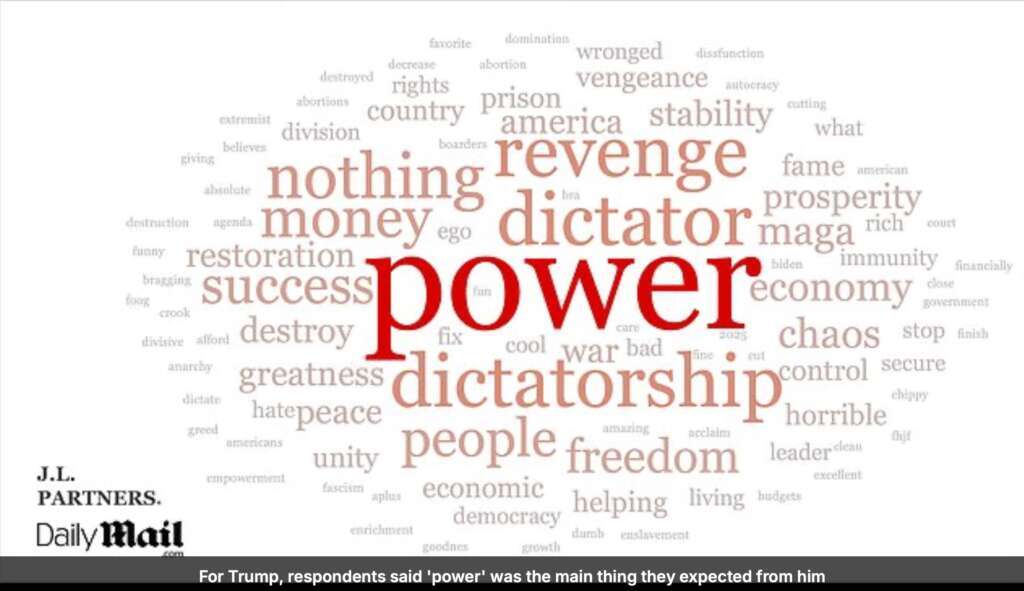

Republican voters, courtesy of J.L. Partners and Daily Mail.
Americans made a choice last November. It was not a landslide, it was not a mandate. Donald J. trump beate Kamala Harris with less than 50% of the popular vote and just more than fifty percent of the state. Had Elon Musk not poured hundreds of millions of dollars into the flagging coffers of the republican candidate during the last few weeks of the campaign, the outcome might have been different. As it is, we now have the best president that money can buy.
APRIL 1, 2025 (TUESDAY)
After a brief pause, the drama is starting to build again. Tonight, there are two congressional seats up for grabs in a special election in Florida. The republicans are expected to win both, but people will be looking at the margin of victory to see if President Trump’s popularity is losing some luster. One reason this might occur is because his tariff war with many different countries begins tomorrow. He’s counting on the leaders of Canada, the EU, China, Mexico, etc. to give in to him. This is how bullies get their way. Canada, however, seems intent on making things painful for America. In that case, Americans will have no one to blame except our President. If these countries push back, there is ony so far Trump can go in response. In other words, he is running out of cards to play.
He is already on record as saying “I couldn’t care less” if Americans must pay more for American automobiles. What kind of servant of the people has an attitude like that? He believes that in the long run, prices will drop. But do you think products such as iPhones and automobiles will get cheaper if American workers build them from scratch instead of workers in third world countries who earn only a fraction of what American workers earn? Meanwhile, it would not be premature to tighten your belts another notch. Prices will rise.
APRIL 3, 2025 (THURSDAY)
Today is being proclaimed as “Liberation Day” in America which is another charade. The only things being liberated are hundreds of thousands of U.S. workers who need jobs, Canada from the illusion that America is their friend and ally, NATO countries who feel they need U.S. defense contractors for future procurements when France, the U.K. and Germany make perfectly acceptable options, unified standards of education across the country, protection for racial groups and other minorities and so on. You cannot assess today’s damage to the economy, to high school seniors trying to apply to university, to the elderly who need Medicare for cancer treatments, to the estimated resale value of your home and so on in the number of characters you have on whatever Musk calls a tweet today.
Now, in case you don’t know, I am an evangelical Christian, though I no longer use that term lest anyone confuse me with the MAGA church people. So, my beliefs define me as a conservative. However, the way I practice and act on those beliefs makes me liberal. I cannot take much comfort out of having excellent health insurance or a paid off home when so many other people do not. They can’t. Maybe they are making poor choices like sleeping late when they know they should be at work, or doing drugs, or maybe the battery on their wheel chair died unexpectedly and they can’t get to class. They were born with spina bifida and are paralyzed. Or they had a catastrophic post-partum stroke at the age of 32. Yet, they want to experience the dignity of work, or making a difference nonetheless. Whether they paint something or design something, they want to be able to say “I did that!”
Unfortunately, we are born with different challenges. Some differences make it easier for us to succeed in life (like a $3,000,000 trust) or being born white in America and some drag us down. I’ve never seen a house worth more than $350k with a wheel chair ramp in the front. We can’t generalize or paint everyone with the same brush stroke.
In times like these, I look for a diversion. This might be an interesting television series like “A French Village” or “Paradise.” I also deal with stress by immersing myself in some other topic, such as space.
How are you doing?
APRIL 7, 2025 (MONDAY)
The market analysts are calling today “Black Monday” and the New York Stock. Exchange (NYSE) won’t open for another two hours. But today’s markets in Toyko, Hong Kong, Berlin and London have fallen drastically on the basis of the tariff war and the future’s market in the U.S. from this past weekend is down, so I expect another plunge.
Huge demonstrations in dozens of cities that will only get larger as the weather warms and things get worse. THankfully they have all been peaceful.

Deena and I plan to “hunker down” in terms of not making any major purchases this year unless absolutely necessary. It looks like the U.S. and the world will have a good deal of pain because of the misguided actions of one man. The problem for our president is that not every country in the world will kowtow to his bullying. Some (like China) are just as likely to push back, and I doubt our Leader has a plan B. The sooner we all wake up to the creeping fascism in America, the sooner we can restore democracy (even though it was democracy that allowed DJT to gain access to the White House for a second term.)
This whole mess is a real challenge to those Christians who try to follow and apply the teachings of Jesus. Our spirit prompts us to “stay above the fray” and not wish ill will or painful consequences on anyone (especially those who voted DJT into office.) One the other hand, our “flesh” or sinful nature hopes that the blinded MAGA crowd learns a painful lesson out of this. At the moment, I’m fighting this notion the best I can. Eventually, I’ll either feel sorry to see or read about their grief and contrition or the Holy Spirit will rebuke me for my callousness.
APRIL 9, 2025 (TUESDAY)
Another fine day in the Golden Age of America. Stocks are crashing around the world as China pushes back against the president’s bullying. Our market will be well inside bear territory by the end of day if projections are correct. Karoline Leavitt, Trump’s press secretary confirmed last evening that her boss is thinking of sending American citizens who are repeat, violent offenders to notorious prisons in El Salvador and elsewhere if the U.S. Supreme Court lets him. Of course, it wouldn’t stop there. He would try to send political opponents, retired military officers who criticise him, members of the press corp and people he sees as disloyal there as well. I’ve learned after ten years of observing him closely that an ordinary citizens’s best approach to his presidency is to expect the absolute worst. At least that way you are prepared, and if it turns out that the worst does not happen, then that’s a cause to celibrate.
Expect an economic depression. Whether or not we are in a recession at the moment is a technicality since you need two consecutive quarters of falling production and he has only been president for less than three months. By summer, the word “depression” will start to be whispered hear and there in the press unless he backs down from this insane interference with the economy.
Expect war. Probably not with Russia because he treasures what he perceives as his personal friendship with Vladimir Putin. More likely it will be with Iran, maybe with China over Taiwan. Denmark and Greenland? Our president needs to flex his muscles from time-to-time so he looks for an easy target.
Look what has happened to our university system in three months. Professors afraid to teach their subjects (gender studies, evolution, politics, environmental studies, history); institutions pushed to the brink of bankruptcy, incoming freshment students cannot get their FAFSA applications processed, international students afraid to come to America. It goes on.
Another female general officer (in this case, and admiral) was canned, presumably for stating that our strength is in our diversity and for asserting the positive contributions or character of women. That only leaves 66 women over the pay grade of 0-6 in our armed forces.
So, my wife and I are coping the best we can and looking for other diversions. We have some vacation time this summer. We watch television programs (most recently Love on the Spectrum)
APRIL 11, 2025 (FRIDAY)
So, it’s Friday and that means (1) the Stock Market is dropping again (though it closed with a very modest gain) and (2) another senior officer in the U.S. Armed Forces has been fired. As common these days, this dedicated officer was a woman. The generic reason was that the Trump appointed male, civilian leadership in the Penatgon experienced a “loss of confidence in her ability to lead.” I’m not sure what signal Donald Trump, JD Vance or Pete Hegseth is trying to send. Are women no longer welcome to serve their country? Is the Cult-formerly-known-as-the-Republican-Party trying to push them back into the kitchens of American homes? After all, our “family values” Speaker-of-the-House Mike Johnson had only last week insisted that a woman who had just given birth must fly to Washington in order to cast their vote on the floor of the House of Representatives. Even after the compromise he made with women in his own party on the issue, they can not have their vote recorded, but rather their vote cancels out the vote of another member of Congress.
THE MARKETS
Our leader has no depth in his understanding of the market, has bad instincts which probably accounts for his numerous business failures, and gets bad advice from his economic advisors. After his April 2 round of tariffs, he said 75 countries have fallen over themselves to make a deal with the U.S. This information from an administration that is truth-challenged. Regardless of whether it is indeed 75, or less than 7, China is not one of the countries. There are undoubtedly republicans that are policy experts on China (and Peter Navarro is not one of them) who would not be afraid to tell President Trump the truth because they do not have jobs to lose in doing so. They might say that Asian countries view things differently than we do. China, once called the “Sleeping Giant” is now wide awake and competing with the U.S. in east Asia and elsewhere (Africa, Central America) for influence. It is and always has been in the U.S. interests to wean China away from communism towards capitalism. But recently, thanks to our leader, Communist Party broadcasting in China is suddenly once again extolling the virtues and propaganda of Mao Zedong about the danger American presents and the evils of capitalism. China will not bow down to the U.S. They may not start a war (or they may over Taiwan if our own government cannot keep things together.) Chinese prestige is on the line. If I could advise any of the previous forty-four people who have been president of our country, I would remind them that you can attract more bees with honey than with vinegar. That advice, unfortunately, would be wasted on this president. So, China now has 125% tariffs on U.S. products. Why not counter that with 1,500% tariffs? Then China could respond by raising their tariffs to 1,800%. Where does this nonsense end?
There may come a time when my opinion and my first amendment speech as I express here in this post and elsewhere is deemed treasonous. I may eventually be arrested and my wife and I have discussed this possibility. Before they come for me it is likely that attorneys, journalists, television personalities, academicians, some former members of Congress, retired military officers, even federal judges might be indicted as well.
And you think this won’t happen? It’s been less than three months. Should I be working on learning Spanish? Or maybe German?
APRIL 12, 2025 (SATURDAY)
There are so, so many unconstitutional actions being taken by the administration almost on a daily basis. One day, it is whisking Hispanics who may have committed no more than a misdemeanor out of this country to foreign prisons without due process (Fourth Amendment and Sixth Amendment) and in direct violation of an order by a federal judge. Even when the administration admits they made an error, they are willing to leave this person to his fate in some foreign dungeon with the same cutthroats he fled from. POTUS reserves the right to interpret the Fourteenth Amendment as far as birthright is concerned. By denying the Associated Press access to the White House press briefings until they stop calling the body of water as out southern border the “Gulf of Mexico,” they are abridging freedom of press (First Amendment.) Scanning the cell phones of people coming to the U.S. on a visa or the social posts of people visiting this country is likely a violation of the Fourth Amendment. POTUS is also actively looking for a way to disregard the Twenty-Second Amendment (term limits for President.) Most recently, it is again the First Amendment, where State Department employees are being directed to report any anti-Christian bias which likely includes remarks (speech.). The instructions say ““Reports should be as detailed as possible, including names, dates, locations (e.g. post or domestic office where the incident occurred…”) I find this troubling for several reasons.
First of all, because I am a Christian. I get weary of people using God’s name in vain or making crude jokes about Christianity. Muslim countries won’t put up with this as far as Allah and Mohammed are concerned. But do we want to live in a country like that?! God is God and will respond or not in His own good time. I don’t want people punished because they don’t believe as I do. I dont want to go to jail if I visit Salt Lake City because I’ve done something offensive to Mormons.
Secondly, it something can be taken from one group and given to another, then it can easily be done to other groups. In European it is a crime to deny the Holocaust. To me, it is dumb to do this. I’ve met at least one person who survived the death camps. I hope we never see something such as this repeated. But should it be a crime to make an unfounded historical statement? Or for a child to draw a picture of God? Not in my book.
APRIL 13, 2025 (SUNDAY)
So, yesterday Deena asked me to watch a video segment by Bill Maher. I knew who he was, but like many broadcast personalities (e.g. Jon Stewart, Steve Bannon, Joe Scarborough, Joe Rogan, Sean Hannity, et al) I do not follow them for one reason or another. But I watched the video closely. He had just had a private dinner and a tête-à-tête with President Donald Trump. He wanted to explain to his followers that DJT can be very charming, affable, and so on. Maher also went out of his way to demonstrate that he did not drink any kool aide at the dinner because he still had policy differences with the President. And, while Maher was very impressed by his time with DJT, I was not impressed by Maher’s account. In fact, I was even more so alarmed. To me,it is one thing to be incorrigible because one could argue that this is the way a person is–they can’t help themself. But to understand that there is a humanitarian, selfless side of DJT which he rarely draws on makes things that much worse. This is what I was thinking as I reflected on the video . . .

There are people I’ve met that are positively volcanic in terms of anger. You would not want to be around them in any circumstance or any time of day. Then, there are people who are kindhearted, the salt of the earth. Then, again, there are people who are a little of both. Imagine marrying some guy who has charmed your friends and the people around you to think he should be “Husband of the Year.” But in the home when no one is watching, he brutalizes you, abuses you, runs you and your children down. You try to tell people as you seek help but no one believes you because he has them fooled. I believe that POTUS earned a lot of good will from Maher’s gushing account simply by being decent for two hours. I wondered when the other 231,000,000 of us Americans would see this? By this I mean, DJT didn’t repeat the story to Maher of how John McCain’s family declined to thank him for their father’s funeral when he died. He didn’t brand retired general Jim Mathis yet again as a trator. He didn’t mention how world leaders are begging him for tariff relief. He didn’t talk about “shit-hole” countries or refer to his Vice-President as an “ass-kisser.” This suggests to me that DJT can act like a decent, classy guy if he wants to and inspite of his Narcissistic Personality Disorder that White House physicians fail to diagnose. According to the DSM V-TR, the hallmarks are:
- A grandiose sense of self-importance (eg, the individual exaggerates achievements and talents and expects to be recognized as superior without commensurate achievements)
- A preoccupation with fantasies of unlimited success, power, brilliance, beauty, or ideal love
- A belief that he or she is special and unique and can only be understood by, or should associate with, other special or high-status people or institutions
- A need for excessive admiration
- A sense of entitlement (ie, unreasonable expectations of especially favorable treatment or automatic compliance with his or her expectations)
- Interpersonally exploitive behavior (ie, the individual takes advantage of others to achieve his or her own ends)
- A lack of empathy (unwillingness to recognize or identify with the feelings and needs of others)
- Envy of others or a belief that others are envious of him or her
- A demonstration of arrogant and haughty behaviors or attitudes
You decide
You decide if the shoe fits! And again, I would be first one to admit I was wrong about the man and ask him to forgive me if I were to see him in prayer, on his knees, with tears in his eyes asking God for help in leading this nation. Asking God for wisdom and guidance, compassion, mercy and love for his fellow man regardless of their net worth.
APRIL 14, 2025 (MONDAY)
As the White House continues to contradict itself on tariffs and behave as though no one has a clue as far as economics and finance is concerned (certainly not President Donald Trump or Commerce Secretary Howard Lutnick), the focus must shift to investors overseas who in Japan own over a trillion USD in U.S. securities while China and the U.K. own another $1.5 trillion combined (more on this in a second.) China, which has not backed down from Trump’s trade war has “upped the ante” in another unexpected way–by refusing to export rare earth metals necessary for our military drones and robot production among other things. In other words, China is not just charging more for these elements in response to Donald Trump’s policies, but they are taking them off the market completely! The urgency that we have to purchase them may well be greater than China’s need to sell them.

Now, to the currency and bond markets. As Americans are getting increasingly frustrated by the daily “on again/off-again” trade war launched against the world by this administration and even before prices start to rise and they personally feel the pinch, investors overseas are reaching the same conclusion as the democrats in the U.S. have; that the U.S. dollar and the U.S. economy may very well collapse. What this means is not just what is happening today, but what happens tomorrow, after a recession which we almost certainly find ourselves in, after less than ninety days of this Presidency? When republicans, themselves, in the U.S. Senate are referencing the Great Depression to understand the dynamics and the peril we are bringing on ourselves, then you know there is a problem.
Look for the U.S. dollar to slide vis-à-vis other currencies in the weeks ahead as overseas investors shop for a more stable economy than the U.S. The Bank of Japan or the Deutsche Bank really doesn’t care about our war on diversity, equity and inclusion, or our immigration policies. They do care about losing their money and investments by betting on the U.S. which seems to have lost its way. Whether the U.S. really has lost its way is not important, because these investments are based on perceptions and confidence, and confidence in the U.S. is lower now than it has been in generations.
APRIL 15, 2025 (TUESDAY)
The London Stock Market (FTSE) soared yesterday because of remarks made by Vice-President JD Vance. He said there was a good chance of a “great” trade deal between the U.S. and the U.K. He pointed out that Americans and British has a shared kinship, that President Trump loved Queen Elizabeth and has great respect for King Charles, that President Trump has properties in the U.K., is an [arguably–ed.] successful businessman, etc. The British investors acted like they saw “visions of sugar plums dancing in their heads” when these marks were reported. Of course, this may be true. Not everything this administration says is a lie, even if that it their most common strategy. On the other hand, Vance might have been “playing” the British, raising false hopes, while trying to break the U.K. further away from the EU with a dubious promise of prosperity. And, America has far fewer friends in the world than it did three months ago. One friend (in the U.K.) would be better than none at all! Trump will no doubt claim credit for soaring stock values in the U.K. while hoping that the casual British observer forgets that he was the one who caused them to crash in the first place.
KUDOS TO HARVARD U.
After an absolute debacle at Columbia U (another private college) where the federal government threatened to withhold hundreds of millions of dollars, possibly for student aid or government contracts, scientific and medical research and so on without any proved malfeasance at the university other than President Trump’s unhappiness over how they dealth with student demonstrations, what the universities taught and how they taught it, Harvard is now standing firm against a second round of bullying and prior restraint. Usually, it must be demonstrated that there was a misappropriation of funds at a university before the government can impound appropriated funds. Plus, the university is allowed its day in court as a matter of due process. But this administration wants to supervise what Columbia teaches regarding the Middle east, Africa and Asia as well as other areas as the price of releasing funds. Based on what Secretary Kennedy is doing in HHS and the firings of climate change investigators at NOAA and the weather bureau, President Trump does not intend to waste money on scientific research, cures for diseases such as AIDS and so on. No doubt his priorities deal with tax cuts for billionaires, companies he hopes to do business with in the future, and so on. Other universities which are being threatened include Northwestern, Cornell, Princeton and Stanford.
The Nazis understood very well the need to indoctrinate university students to Nazis teachings, the Nazis worldview and the National Socialist agenda, while eliminating free thought and speech by professors who were Jewish, Democrat and liberal. Ninety years later, we are witnessing this present government covering the same ground once again on another pretense.
APRIL 17, 2025 (THURSDAY)
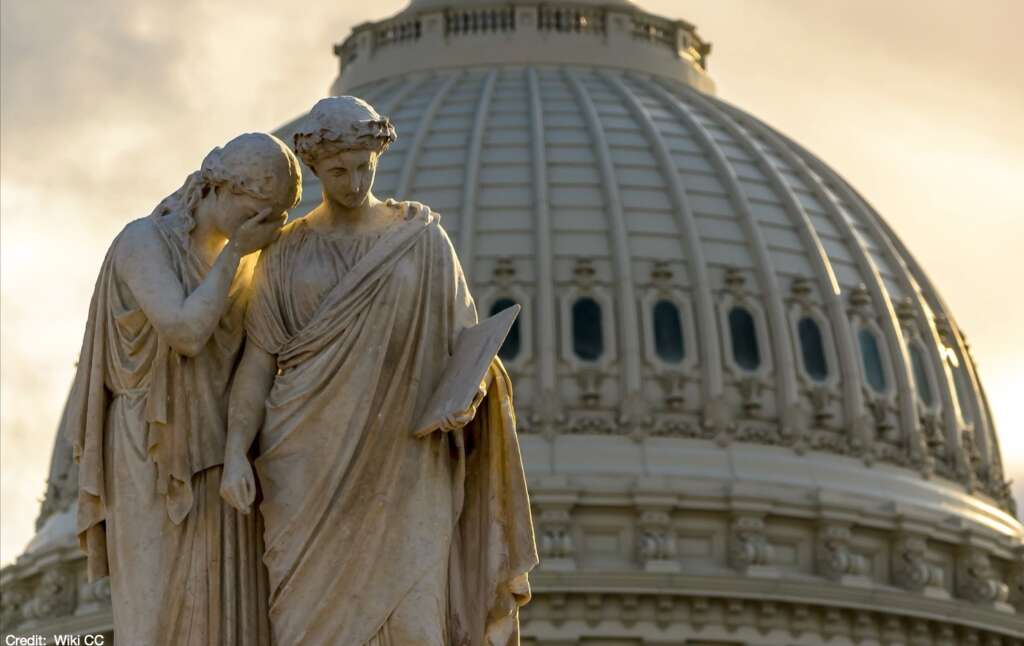
Another crazy day. Trump defying district court demanding return of Abrego Garcia from El Salvador. Deena asked me why he hasn’t been returned. I replied that possible POTUS wants to force the issue by defying the court. To that end, the Administration released some dirt on Garcia about a restraining order from a few years ago. Or, Garcia is already dead. Locally, the response has been supportive of POTUS (Garcia is a gang member, he’s a violent husband, he’s here illegally anyway and now he’s back in his own country, etc.) Only one or two people are perceptive enough to understand that this is much larger than one person. It is an assault on procedural due process. Because of this I did an editorial this a.m.
Now, Trump is seeking to send violent Americans to El Salvador, but it won’t stop there if the SCOTUS allows it. Another issue was DJT’s personal attack on the Chairman of the Fed (Jerome Powell.) Trump needs Powell’s help manipulating the Stock Market to minimize the damage of Trump’s reckless economic policy. Powell wisely remains aloof. DJT will almost certainly seek to fire Powell. Hopefully Powell will fight it and the Court will support him.
Finally, I head some comments from Senator Barbara Murkowsi (R, AK) about the fear of speaking out among her GOP colleagues. She seems to be concerned about much more than a primary challenger when she comes up for reelection. If you watch and listen to the video, she is careful in choosing her remarks and does not rule anything out. Thirty months ago a guy with a hammer (GWAH) tried to whack (then Speaker) Nancy Pelosi. Last week another GWAH was only feet away from reaching the Governor of Pennsylvania in his home at 2:00 a.m.
I read Murkowski’s comments in an Anchorage newspaper and many respondents said they did not feel badly for her. If she believes DJT is a dangerous person, then she should not be confirming his dubious appointees (point well taken.) Also, that Alaskans depend on her being courageous. She is frightened as we all are.
Next Wednesday, Deena and I fly to Washington DC for the day. I told her I’m leaving my phone at home in case we run into some agents who want to search my phone with no probable cause or court order. I have nothing criminal on it, but as the law seems to be changing day-by-day now, I don’t want to make it easy to be delayed and miss my connections. I read earlier this week that European Union representatives who must visit the U.S. on official EU business will be issued “burner phones” to keep U.S. authorities from spying or collecting intelligence on EU (i.e., free) countries. The only other country that the EU applies this to is when they must travel to China. This shows how our allies now classify/regard us.
MAY 6, 2025 (TUESDAY)

A lot has been happening. There is no cessation in the drama out of Washington. One minute the official White House X account is broadcasting an AI image (or at least, hopefully a CGI image of Trump as Pope, lest he actually has the vestments) while the Catholic Church is still mourning the death of Pope Francis and the next minute you hear of negotiations in progress to send undocumented migrants caught in the U.S. to Rwanda in Africa. Strangely, the evangelical community has not criticized President Trump for his poor–perhaps even sacrilegious–taste. St. Peter in his first epistle (4:8) notes that love covers a multitude of sins. My evangelical brethren are tolerating a lot more outrageous behavior from this man than they would Bill Clinton or Barak Obama. I wonder whether before long will see an image of Trump crucified on a cross? It certainly would not surprize me.
MAY 28, 2025 (WEDNESDAY) TNEW
Last week I was scheduled for day surgery to scrape off some more of my bladder lining for a cancer check. After getting an IV, catherization, consents to sign and wheeled in to surgery and put to sleep, I was awakened and informed that the anesthesiologist could not successfully place the endo-trach in me so they had to scrub the surgery. It will be performed in a week at the main hospital OR where they have more resources.
In the interim, things have continued to rot in the federal government. It gets more and more corrupt each day. This week it has involved freeing a felon from jail after a family member paid a million dollars to attend a Trump affair. Then, there is the bitcoin mess. I think the U.S. government should stay out of bitcoins for now, but Trump junior has jumped in, talked his dad into joining him, and now the U.S. government will wind up imdemnifying the Trump family against loss in a very volatile venture. The world becomes mored chaotic each day as Trump says one thing, then contradicts himself the next day, onlt to make a new absurd pronoucement the third day, etc. The CDC has backed off on COVID immunizations for healthy people per Robert Kennedy’s instructions, and today the word from Kennedy is that U.S. researchers and doctors will be prohibited from publishing their findings in JAMA, the New England Journal and Lancet to name just a few prestigious journals. The U.S. has also pulled our of the WHO per Trump’s demands. Kennedy notes that the government may publish their own “sanitized” medical journal where politics and newspeak “trumps” science. I scarcely believe anything the CDC says anymore because of Kennedy’s presumed meddling and the resignation or firing of anyone who pushes back.
Locally, the fire siren has gone off three or four times in the fast few hours. My town has a loud Klaxon sort of horn that blows repeatedly when firemen are being summoned. Earlier today, while driving home from the grocery store I saw four police cars and a few civilian cars on either side of the road. I thought there was an accident, but the cars seems okay. In a parking lot to my right there was a small crowd of people and a few police officers standing around a man down on the pavement. I assumed it was a medical emergency and they were waiting for an ambulance, rather than an arrest. Because I have apophenia, I have a tendency to look for a common denominator to random events. Given the sour state of international affairs between the U.S. and Russia (made worse since Trump was inaugurated), I get a bit nervous when I hear alert sirens.
